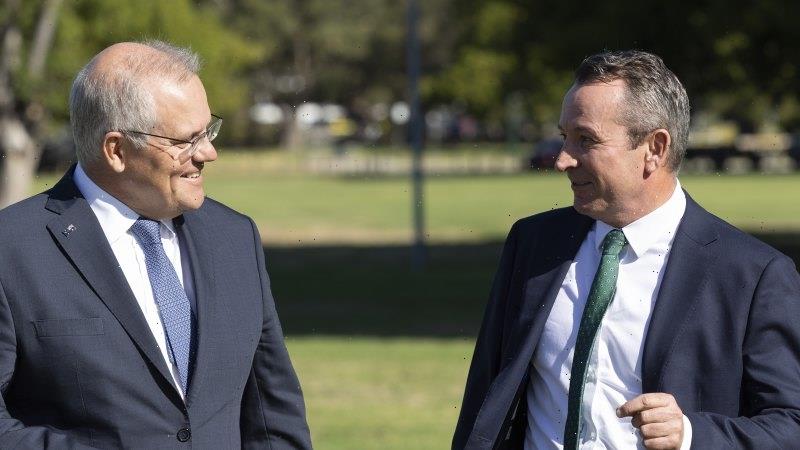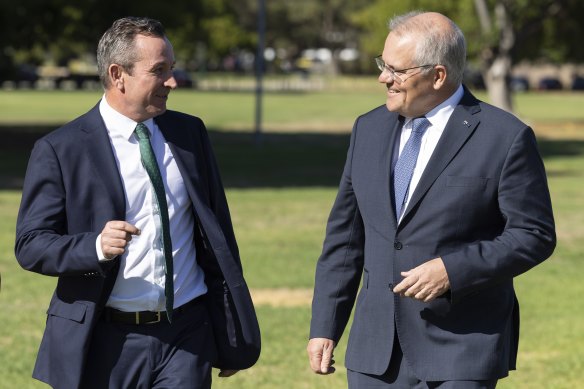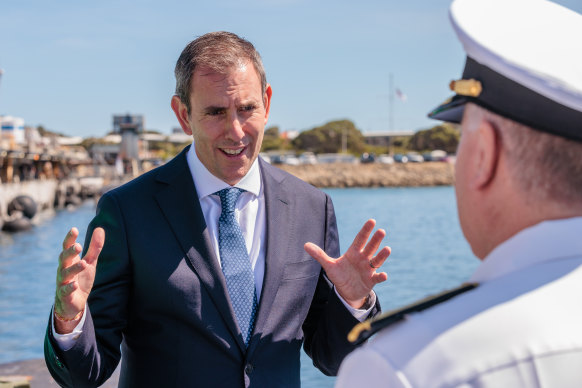The cost of a deal aimed at protecting Western Australia’s share of the GST is growing faster than the National Disability Insurance Scheme, the interest bill on government debt and defence spending after blowing out another $600 million in less than six months.
Details of the annual carve-up of the goods and services tax among the states and territories show the price tag of a deal put in place by the Morrison government is now on track to surpass $25 billion since its inception while leaving a potential hole in the budget when it ends.
Scott Morrison and Mark McGowan in Perth during the 2022 election campaign. Morrison’s plan to boost WA’s GST is on track to cost taxpayers almost $25 billion.Credit:Matt Jelonek/Getty Images
The Commonwealth Grants Commission every year allocates the GST based on a complex calculation of the relative financial strength of each jurisdiction. Due to high inflation the tax is expected to raise a record $86.2 billion in 2023-24.
Throughout the 2010s, WA’s share of GST collapsed due to the surge in the state’s iron ore royalties. In 2014 it reached an all-time low of 30 cents for every dollar raised within the state.
As treasurer in 2018, Morrison struck the deal that WA would receive a minimum of 70 cents in the dollar from 2022-23 before increasing to 75 cents in 2024-25. When the policy was put in place, it was expected iron ore prices would fall and WA’s share of the GST pool would therefore rise. Instead, prices soared and have remained elevated ever since.
The Morrison government ensured other states and territories would not be worse off under the deal, requiring top-up funding from outside the GST pool.
The plan was originally forecast to cost federal taxpayers $2.3 billion over three years, including just $293 million in 2021-22, but the surge in iron ore prices has meant larger top-ups for longer.
In October, Treasurer Jim Chalmers revealed the cost in 2021-22 had jumped to $2.1 billion, was forecast to reach $4.1 billion this year and then edge up to $4.3 billion in 2023-24.
But on Monday, the grants commission revealed the top-ups to other states would likely reach $4.9 billion next financial year.
By 2025-26, the cost of the entire deal is on track to reach $23.1 billion, with another $2-3 billion likely the year after that.
The 10-fold increase in the cost of the program now dwarfs increase in costs for programs including the NDIS, aged care, health or defence.
Treasurer at HMAS Stirling in WA on Tuesday. He said the government would stick with the GST top-up policy of the Morrison government.
Chalmers, in WA, said the government was committed to the deal left by the Morrison government.
He said without the deal, WA would have received 10 cents for every dollar of GST raised within the state or $5.6 billion less than what it will get in the coming financial year.
“This is a deal that we are committed to, this is a deal that we are proud of, this is a deal that
ensures that we recognise that the Western Australian economy often keeps the wheels of the national economy turning,” he said.
The no-worse off provision of the GST carve-up is due to end at the end of the 2026-27 financial year. Without the provision, NSW’s share of GST in 2023-24 would be $1.7 billion lower than expected while Victoria would have a $1.4 billion cut to its allocation.
Chalmers said the government would turn its mind to the issues around the end of the no-worse-off provision in four years’ time.
The grants commission confirmed an extra $3.1 billion in GST is expected to be collected in 2023-24. Of that cash, South Australia will receive $943 million, Queensland will get $673 million while Victoria’s share will be worth $621 million.
Cut through the noise of federal politics with news, views and expert analysis from Jacqueline Maley. Subscribers can sign up to our weekly Inside Politics newsletter here.
Most Viewed in Politics
From our partners
Source: Read Full Article



